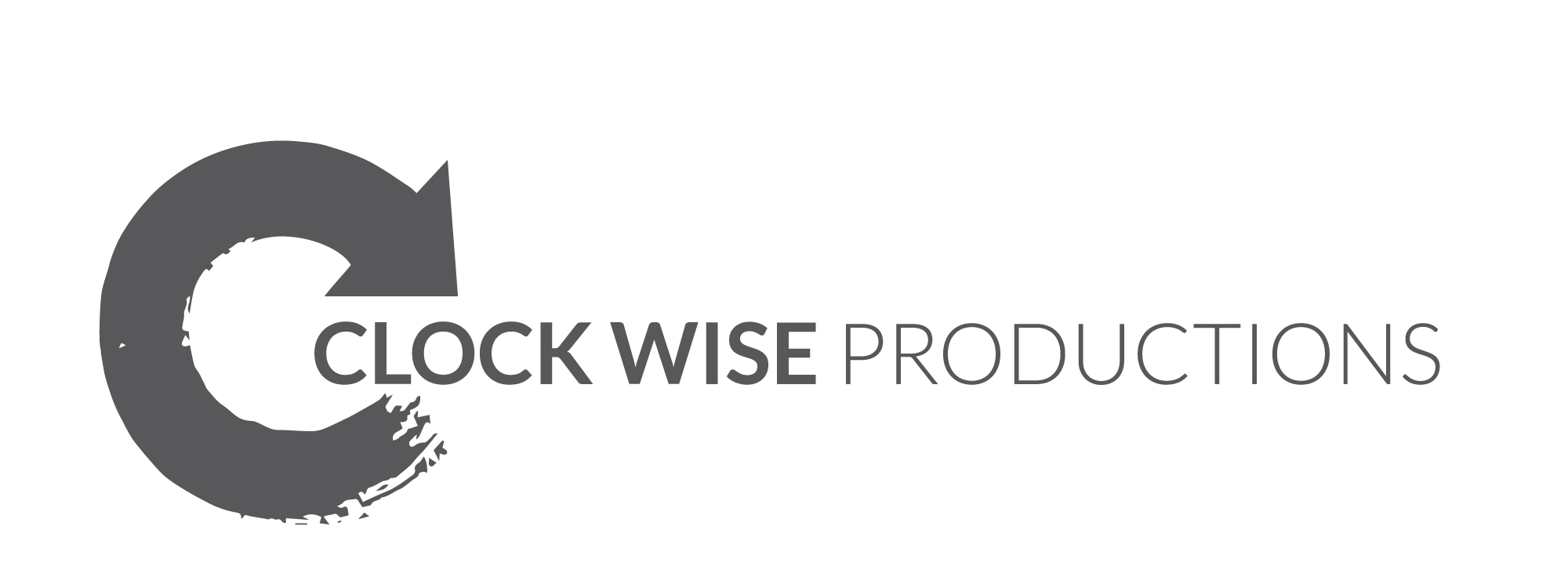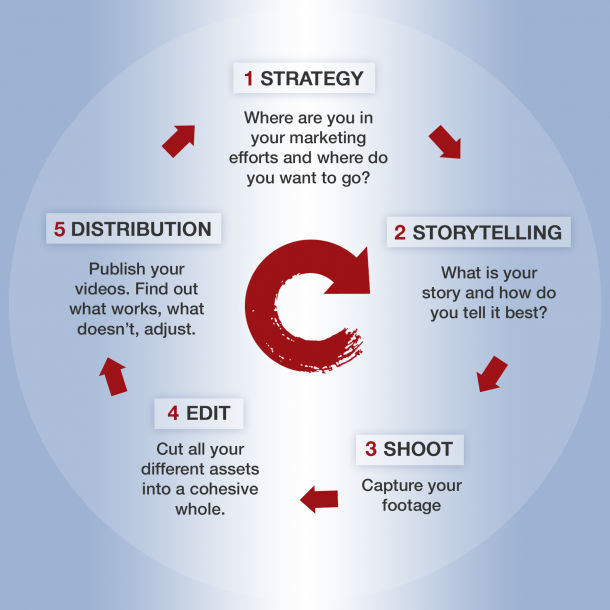A few years ago, as I started focusing on video marketing for small business, it all seemed crystal clear to me. There were five stages of video marketing: development, creative, pre-production, production, and post-production. Those categories were what I knew as a filmmaker.
As you can see, these five steps did not include strategy, distribution, or analytics! Since, I have come to realize, that what I knew about back then was video PRODUCTION, not video MARKETING.
Today, after years of hands-on experience, I have a clear understanding of what a small business owner needs to know to be successful at video marketing.
My focus has shifted from sharing all that I know, to sharing what clients need to know for a successful, sustainable, cost-, and time-effective video marketing strategy.
My focus has shifted from sharing all that I know, to sharing what clients need to know for a successful, sustainable, cost-, and time-effective video marketing strategy.
In this post we will go over:
- Video Marketing Basics for Strategy
- Why You Should Commit to Consistent & Continuous Content
- How Your Video Marketing Strategy Revolves around Your Audience
- What to Keep in Mind: Best Practices for Video Marketing Strategy in 2018
As a small business owner, what are the 3 most important things to know about a video marketing strategy?
-
- Strategy informs distribution, and the outcome of your distribution efforts informs your next round of strategy. In other words: Video marketing is a feedback loop that starts and ends with strategy (see diagram above).
- Storytelling, shooting and editing are merely the execution steps, called Video Production.
- Video content is directly impacted by the context of where it is watched.
With smartphones and social media platforms prominent in our daily lives, video is the most powerful marketing tool for any size business.
Using strategy, you can optimize video marketing for your goals.
Commit to Consistent & Continuous Content
Marketing (digital or not) is the holistic entire marketing effort you put out for your company. Video marketing, or production might ver
y well be a big or small part of that effort.
If you’re looking for a video or two on your website to show off what you do, who you are and just go with the whole “video-is-a-must-hype” vibe, then that’s perfectly legitimate. A lot of small business owners do that, but that’s not really video marketing in a holistic sense. It is digital marketing that happens to have the elements of video be part of it.
Video Marketing is a continuous and consistent effort to attract, engage, and convert customers with the help of video.
And Video Marketing is an investment – no matter how you dice it. Either your time, or your money, mostly a combination of both. The holy grail is finding the sweet spot where the amount of time and money that you’re spending is the least painful in getting your ideal video marketing results: attracting, engaging, and retaining customers.
So, if you want REAL success with your video marketing, make a commitment to be consistent and publish continuously.
- Consistent content will make you part of your prospects or existing client’s life – you publish reliably and consistently, and they will share your content, recommend you, and when they’re ready to buy, you will be at the top of their minds
- Continuous content will give your prospect something to come back to and continuously learn from you. Be that reliable source with great advice, funny anecdotes, or fast tips. Be that expert voice and show them why they would absolutely want to work with you.
- Make that Commitment to using your video marketing powers: There is a learning curve to video – make the most of your time and money.
Your Video Marketing Strategy Revolves around Your Audience
When approaching the strategy step of video marketing, start by asking the following questions:
1. How does video tie into my overall marketing strategy?
Almost 50% of internet users are looking for video related to a product or service. Marketing giant HubSpot reports, “Video is often cited as the tool that help drive various areas of business performance, and the numbers back up these claims”. For instance, they report that 72% of people would rather use video to learn about a product or service. Plus, video content is very shareable. HubSpot also reports that 83% of consumers would consider sharing a brand video that they like with their friends. 1
Determine what assets you already have in your marketing strategy and what is missing. Think about what video can do that still images, audio podcasts, and written text (newsletters, blog posts, web presence) will not do.
2. Who is my audience and on which channels do they hang-out?
Determine where you are planning on hosting and disturbing your videos. Are you planning on using your videos only on your website or also on social media channels and the second biggest search engine, YouTube? Chances are that you’ll want to focus on the distribution channels where most of your target audience hangs out.Each distribution platform has its own technical specs, and they change regularly and often. Some of them auto-start videos and others will let you watch a video without audio.
Your video content will not be found and watched if it isn’t in direct conversation with its context. And if you are using distribution channels outside your own web presences, make sure your video content leads back to your business!
For a little more about context watch my short video on the subject:
3. What do I want my prospects to do after watching the video?
The kind of video content that you make should be directly related to where your audience is in the buying cycle. Are you trying to create awareness on your product or covert them from prospective buyer to a customer? Before you figure out what kind of message (call to action) to focus on, you need to know what you want your audience to do next.Here’s a buyer cycle that I reference when I’m making my own marketing videos:
4. What video style works for my message, and the platform that I’m using?
There are many kinds of video: live action, explainer, interview, testimonial, animation, motion graphic, etc. Spend some time on-line “shopping” for videos. Look at videos in your niche, check out your competition, look at random businesses you think are your size, and search YouTube and Vimeo.Which videos do you love, which videos do you find most useful, what styles do you like, which videos to you not like? Make a list to inspire your future videos.
Some types of videos (explainer, testimonial) are easier to do as a DIY marketer, while others (animation, motion graphic) will definitely require hiring a third party. Based on your available resources (timeframe, assets, budget, etc.), choose the type that best suits your business’ needs.
5. What’s my story?
Video is a storytelling tool and has an emotional impact. What is the call to action within your video? Depending on which step you are focusing on in the buyer cycle, you will likely want to tell a different kind of story with a specific call to action.For example, if you want your potential customers to consider your product as the best solution to their problem, you may want to create an explainer video to highlight free consultations and benefits of working with you.
You’ll want to make sure your video lives within your sales-environment and does not stand alone. For this kind of product-aware step, I’d recommend posting videos on your website or embedding them on your social media pages. Your call to action may be something like “We are the best solution for you” with a link or button to your detailed product/service page.
If these steps raise more questions then they generate clear answers, I would suggest investing in a consultation with a video marketing professional to get answers to YOUR questions and to make sure you don’t make in the moment decisions that end up negatively impacting your time and your budget.
Be sure that whoever you hire understands all aspects of video marketing and production from an overall creative, technical, logistical and financial perspective.
Keep in Mind: Best Practices for Video Marketing in 2018
So, what’s dominating trend predictions and what can we call best practices for this year?
-
“Mobile First”: Videos are mostly watched first and foremost on mobile devices
90% of video content is being consumed on mobile devices. That means you should be creating video content that will display and play best on mobile devices. It’s important to note that 75% of all video content watched on mobile is being consumed without sound. Make sure your video is still clear and relevant if watched without sound OR give them a reason to turn on the sound.
-
Attention spans are getting shorter by the minute
Video content is competing with other distractions – the time you have to “hook” your audience has dropped from 8 seconds to 3 seconds!
-
Vulnerability & authenticity are key
As more and more video content become desirable for marketing, and videos are produced by non-video-professionals, the focus shifts from video as a highly-designed art form to authentic, accessible, and raw video content. Live streaming gets prioritized above video, images, and text by search engines and for that reason alone it will be used more and more.
-
There will be more consumer-generated video content
This points to two trends: first, a growing DIY approach to video content and secondly, businesses using client and customer-generated content, which is crowd-sourced and therefore cannot be controlled or only minimally influenced.
-
Video will go deeper into the conversion funnel
More video is expected and consumed in less prominent places like emails, sub-pages of websites, and proposals.
-
There will be many more purpose-driven brand videos
Companies are aligning themselves with worthy causes and will leverage those relationships for their marketing and advertising.
So, when it comes to video content and strategy in 2018, the overall best practice is to focus on getting shorter, more authentic video out there that is well suited for mobile-first viewing.
With these considerations, you are on your way to start thinking about strategy and getting ready to tackle the next step in the Video Marketing cycle: Storytelling.
And remember: there are strategy and distribution (and with that analytics) to contend with when dealing with video marketing. Storytelling, shooting and editing is video production. If you do your homework upfront and keep the video marketing cycle in mind your videos will produce the results you are going for!





